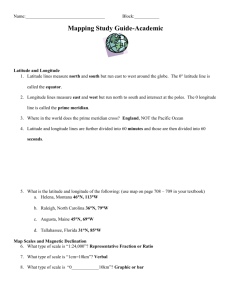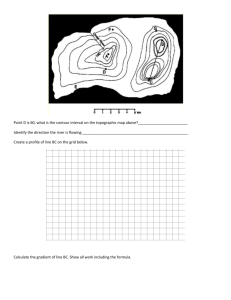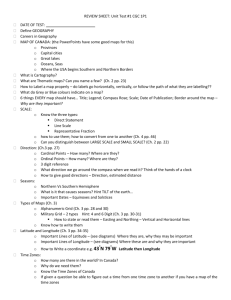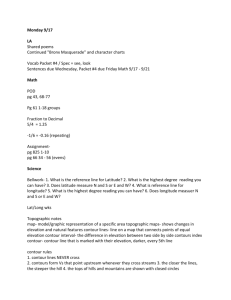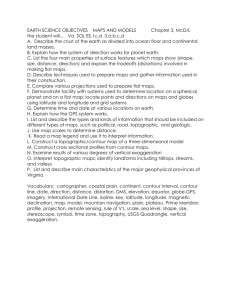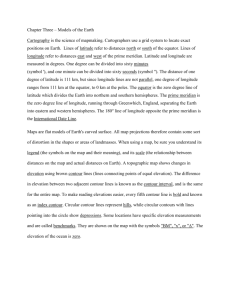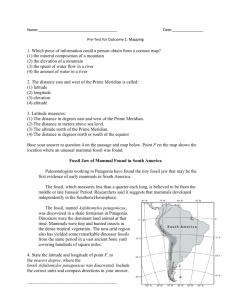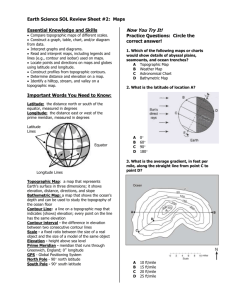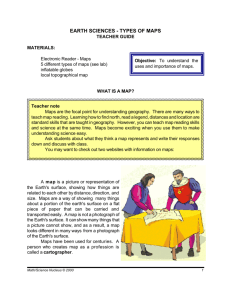Chapter 3 – Maps are Fun
advertisement
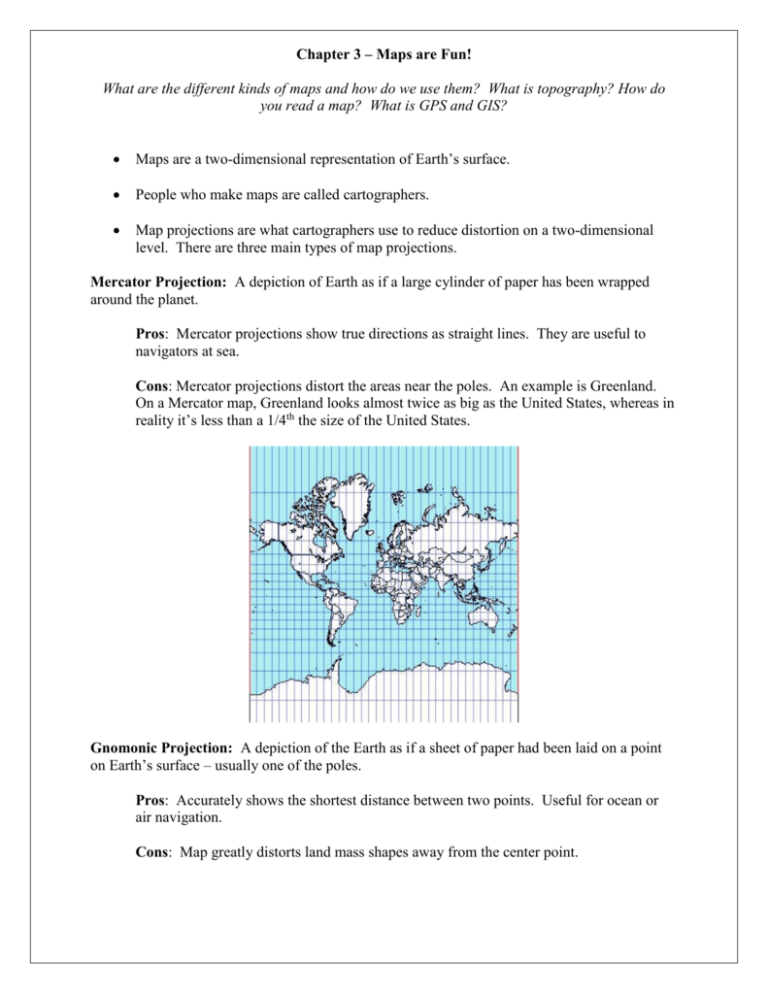
Chapter 3 – Maps are Fun! What are the different kinds of maps and how do we use them? What is topography? How do you read a map? What is GPS and GIS? Maps are a two-dimensional representation of Earth’s surface. People who make maps are called cartographers. Map projections are what cartographers use to reduce distortion on a two-dimensional level. There are three main types of map projections. Mercator Projection: A depiction of Earth as if a large cylinder of paper has been wrapped around the planet. Pros: Mercator projections show true directions as straight lines. They are useful to navigators at sea. Cons: Mercator projections distort the areas near the poles. An example is Greenland. On a Mercator map, Greenland looks almost twice as big as the United States, whereas in reality it’s less than a 1/4th the size of the United States. Gnomonic Projection: A depiction of the Earth as if a sheet of paper had been laid on a point on Earth’s surface – usually one of the poles. Pros: Accurately shows the shortest distance between two points. Useful for ocean or air navigation. Cons: Map greatly distorts land mass shapes away from the center point. Polyconic Projection: A depiction of the Earth as if a cone of paper had been wrapped around the Earth. Pros: Landforms show their true shape and size in relation to each other. Useful for mapping large areas of land that fall in middle latitudes. Cons: Lines of latitude and longitude are curved slightly. Latitude and Longitude The Earth is divided into hemispheres. The equator is a line of 0° latitude that separates the Northern and Southern hemispheres. The Eastern and Western hemispheres are divided by lines of longitude called the prime meridian (0°), and the 180° meridian. Latitude lines circle the world from east to west parallel to the equator. We measure latitude in degrees north or south of the equator. At the north pole, the latitude is 90° north; the south pole is 90° south. Longitude lines are half-circles that run from north to south between the poles. Longitude is measured in degrees east or west of the prime meridian. The prime meridian passes through Greenwich, England. Latitude and longitude can be broken down into degrees, minutes, and seconds. Each degree is broken down into 60 minutes…each minute is broken down into 60 seconds. Map Scales – it’s not how much they weigh! The scale of a map lets you know how the features of the maps compare in size with the actual size of the Earth’s surface. Scales are usually shown in the form of a ratio. For example, one centimeter on the map may equal one kilometer on the Earth’s surface. Map Orientation: We have to make sure when we’re reading a map that we locate the proper directions. The compass rose (an arrow indicating direction) will give you a clue. Evolution of map making: Up until the mid 1900’s, maps were generated by the USGS (United States Geological Survey) using hand-drawings and observations. The use of radar and aerial photography in the 1950’s greatly improved the accuracy and complexity of most maps. Beginning in the 1970’s satellite mapping began to transform the way we look at the world. Satellites not only produce highly detailed maps of the surface, but they also map weather patterns and ocean currents. Most recently the integration of computers and satellites has created a new era in map making and utilization. We call this integration of computers and satellites GPS and GIS. o GPS or global positioning system consists of three simple elements: space, control, and the user. In space there are 24 or more orbiting satellites, the control station is a land-based computer system that is responsible for controlling the positions of the satellites. The user is able to interpret the data received by the satellites by using a hand-held GPS tracking device, or a device in a car, boat, or airplane. GIS (Geographic Information Systems) is a result of combining satellite images, statistical surveys, and other information in order to extract valuable information from a map. A GIS based computer can store, rearrange, and display data in a very usable and user-friendly way. GOOGLE MAPS is a great example of GIS. By typing in your location, Google can find anything from local gas stations to pizza places in your area. How else might we use GIS? Topographic Maps A topographic map shows the topography (or the surface features) in the area of study. It indicates cliffs, mountains, streets, buildings, and other landforms. Topographic maps use contour lines to show the relief (or change in elevation). Most United States topographic maps show an area called a quadrangle that spans 7.5 minutes of latitude and 7.5 minutes of longitude. If you know how to interpret contour lines, you can get a mental picture of the shape of the landscape. Contour lines are narrow lines on topographic maps that connect areas of equal elevation. The difference in elevation between two contour lines is called the contour interval. The distance between one contour line and the next shows you the slope. The slope is how steep a landform is. If contour lines are spaced far apart, the area is relatively flat. If contour lines are close together, it is a steep landform. How to find the slope of a mountain or other landform. You begin at an elevation of 700 feet and you end up at an elevation of 2432 feet. The total distance traveled is 4 miles. How do we find the slope? Remember: RISE OVER RUN – RISE/RUN! o 2432 – 700 = 1732 o Divide 1732 by 4 (1732 / 4 = 433 ft per mile) o 433 feet per mile is the slope of the mountain.
